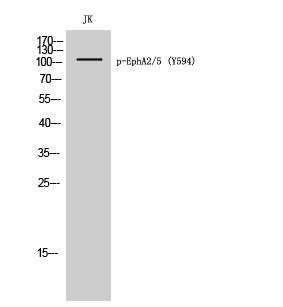EphA2/5 (phospho Tyr594) Polyclonal Antibody
- Catalog No.:YP0506
- Applications:WB;ELISA
- Reactivity:Human;Mouse
- Target:
- EphA2/5
- Fields:
- >>MAPK signaling pathway;>>Ras signaling pathway;>>Rap1 signaling pathway;>>PI3K-Akt signaling pathway;>>Axon guidance
- Gene Name:
- EPHA2/EPHA5
- Protein Name:
- Ephrin type-A receptor 2/5
- Human Gene Id:
- 1969/2044
- Human Swiss Prot No:
- P29317/P54756
- Mouse Gene Id:
- 13836/13839
- Immunogen:
- Synthesized phospho-peptide around the phosphorylation site of human EphA2/5 (phospho Tyr594)
- Specificity:
- Phospho-EphA2/5 (Y594) Polyclonal Antibody detects endogenous levels of EphA2/5 protein only when phosphorylated at Y594.
- Formulation:
- Liquid in PBS containing 50% glycerol, 0.5% BSA and 0.02% sodium azide.
- Source:
- Polyclonal, Rabbit,IgG
- Dilution:
- WB 1:500 - 1:2000. ELISA: 1:10000. Not yet tested in other applications.
- Purification:
- The antibody was affinity-purified from rabbit antiserum by affinity-chromatography using epitope-specific immunogen.
- Concentration:
- 1 mg/ml
- Storage Stability:
- -15°C to -25°C/1 year(Do not lower than -25°C)
- Other Name:
- EPHA2;ECK;Ephrin type-A receptor 2;Epithelial cell kinase;Tyrosine-protein kinase receptor ECK;EPHA5;BSK;EHK1;HEK7;TYRO4;Ephrin type-A receptor 5;Brain-specific kinase;EPH homology kinase 1;EHK-1;EPH-like kinase 7;EK7;hEK7
- Observed Band(KD):
- 110kD
- Background:
- This gene belongs to the ephrin receptor subfamily of the protein-tyrosine kinase family. EPH and EPH-related receptors have been implicated in mediating developmental events, particularly in the nervous system. Receptors in the EPH subfamily typically have a single kinase domain and an extracellular region containing a Cys-rich domain and 2 fibronectin type III repeats. The ephrin receptors are divided into 2 groups based on the similarity of their extracellular domain sequences and their affinities for binding ephrin-A and ephrin-B ligands. This gene encodes a protein that binds ephrin-A ligands. Mutations in this gene are the cause of certain genetically-related cataract disorders.[provided by RefSeq, May 2010],
- Function:
- catalytic activity:ATP + a [protein]-L-tyrosine = ADP + a [protein]-L-tyrosine phosphate.,function:Receptor for members of the ephrin-A family. Binds to ephrin-A1, -A3, -A4 and -A5.,similarity:Belongs to the protein kinase superfamily. Tyr protein kinase family. Ephrin receptor subfamily.,similarity:Contains 1 protein kinase domain.,similarity:Contains 1 SAM (sterile alpha motif) domain.,similarity:Contains 2 fibronectin type-III domains.,subunit:Interacts with SLA (By similarity). Interacts with INPPL1/SHIP2.,tissue specificity:Expressed most highly in tissues that contain a high proportion of epithelial cells, e.g., skin, intestine, lung, and ovary.,
- Subcellular Location:
- Cell membrane ; Single-pass type I membrane protein . Cell projection, ruffle membrane ; Single-pass type I membrane protein . Cell projection, lamellipodium membrane ; Single-pass type I membrane protein . Cell junction, focal adhesion . Present at regions of cell-cell contacts but also at the leading edge of migrating cells (PubMed:19573808, PubMed:20861311). Relocates from the plasma membrane to the cytoplasmic and perinuclear regions in cancer cells (PubMed:18794797). .
- Expression:
- Expressed in brain and glioma tissue and glioma cell lines (at protein level). Expressed most highly in tissues that contain a high proportion of epithelial cells, e.g. skin, intestine, lung, and ovary.
- June 19-2018
- WESTERN IMMUNOBLOTTING PROTOCOL
- June 19-2018
- IMMUNOHISTOCHEMISTRY-PARAFFIN PROTOCOL
- June 19-2018
- IMMUNOFLUORESCENCE PROTOCOL
- September 08-2020
- FLOW-CYTOMEYRT-PROTOCOL
- May 20-2022
- Cell-Based ELISA│解您多样本WB检测之困扰
- July 13-2018
- CELL-BASED-ELISA-PROTOCOL-FOR-ACETYL-PROTEIN
- July 13-2018
- CELL-BASED-ELISA-PROTOCOL-FOR-PHOSPHO-PROTEIN
- July 13-2018
- Antibody-FAQs
- Products Images

- Western Blot analysis of JK cells using Phospho-EphA2/5 (Y594) Polyclonal Antibody



